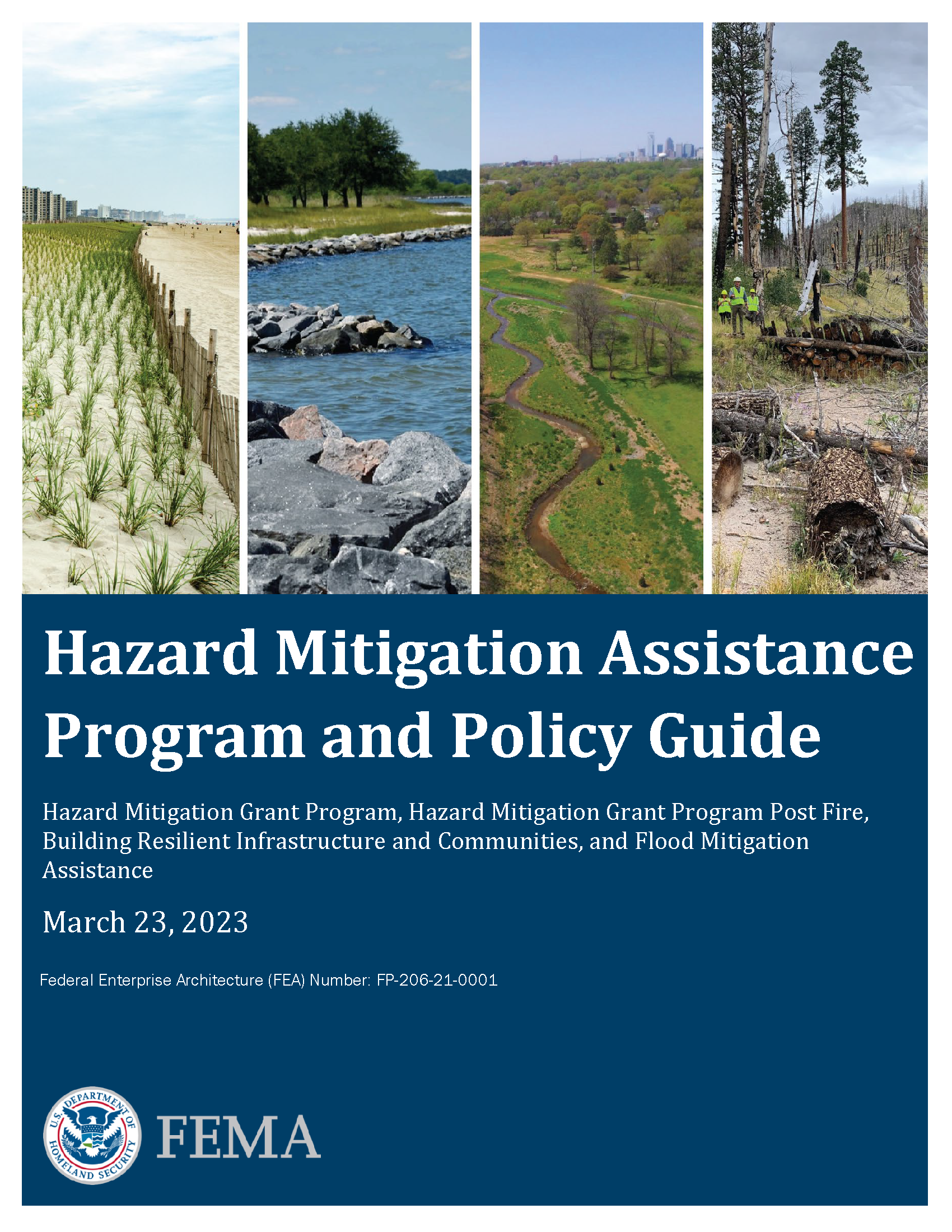FEMA's hazard mitigation assistance provides funding for eligible mitigation measures that reduce disaster losses.
"Hazard mitigation" is any sustainable action that reduces or eliminates long-term risk to people and property from future disasters.
Mitigation planning breaks the cycle of disaster damage, reconstruction and repeated damage. Hazard mitigation includes long-term solutions that reduce the impact of disasters in the future.

Drought Mitigation Policy Aid
This policy aid provides important information on applying for funding for planning related and drought mitigation activities, including additional resources, such as links to partner websites.
Download the Aid
Find Funding for Hazard Mitigation

View the summary of all Hazard Mitigation Assistance Programs, or explore below.
Which Best Describes Your Project?
Rebuilding my community after a major disaster in a way that reduces future disaster losses.
Hazard Mitigation Assistance Program (HMGP)
Reducing the risk of flood damage to NFIP-insured buildings.
Flood Mitigation Assistance (FMA)
Helping my community reduce risks from future disasters and natural hazards.
Building Resilient Infrastructure and Communities (BRIC)
Making my community more resilient after a wildfire disaster.
HMGP Post-Fire Assistance
Implementing one of the 100 Congressional Community Projects that prioritize sustainable & cost-effective measures to reduce risk and/or reliance on federal disaster funding.
Pre-Disaster Mitigation (PDM)
Find Resources for Applying to & Managing Grants

Featured Resource
Access resources to help interpret federal statutes, regulations and best practices about mitigation strategies.
This document provides instructions on how to complete the application for a soil stabilization project under FEMA’s Hazard Mitigation Grant Program (HMGP).
FEMA is announcing an increase in program accessibility for communities for the fiscal year 2022 Building Resilient Infrastructure and Communities (BRIC) and Flood Mitigation Assistance (FMA) grant program application cycle through use of an alternative cost-effectiveness method that will modify the threshold for certain mitigation projects to be cost-effective under limited conditions.
The American Society of Civil Engineers (ASCE) 24-14 is a referenced standard in the 2015 International Building Code® (IBC) and the 2015 International Residential Code® (IRC). Building and structures within the scope of the IBC proposed to be constructed in flood hazard areas must be designed in accordance with ASCE 24-14. The IRC requires dwellings in floodways to be designed in accordance with ASCE 24-14 and includes an alternative that allows communities to require homes in any flood zone to be designed in accordance with ASCE 24-15. Highlights of ASCE 24-14 that complement the NFIP minimum requirements include Building Performance; Flood-Damage Resistant Materials; Utilities and Service Equipment and Siting Considerations.
The MAP, a resource to identify eligible hazard mitigation activities under the Building Resilient Infrastructure and Communities (BRIC) grant program, will tentatively be updated twice a year. Projects can be submitted to FEMA for consideration at any time, using this template, but the selections will only be made in connection with the update.
This job aid supplement covers the requirements associated with the technical reviews for soil stabilization projects funded by Hazard Mitigation Assistance.
This document provides instructions on how to complete the application for a post-wildfire flood risk and sediment reduction project under FEMA’s Hazard Mitigation Grant Program (HMGP). This application is intended to be used only for post-wildfire flood risk and sediment reduction projects, including modifying or removing culverts to allow drainage to flow freely, adding drainage dips and constructing emergency spillways to keep roads and bridges from washing out during floods, and constructing straw, rock, or log dams in small tributaries to prevent flooding.
This Program Support Material (PSM) provides detailed information about phased projects eligible through the Building Resilient Infrastructure and Communities (BRIC) and Flood Mitigation Assistance (FMA) program. The information below includes an overview of phased projects, an explanation on how they differ from project scoping activities, background on the BRIC and FMA Notice of Funding Opportunity (NOFO) processes, and additional information for further reference.
This reference guide provides local communities and non-profit organizations the ability to manage their subapplication processes electronically.
FEMA places a high priority on supporting wildfire recovery using the Hazard Mitigation Grant Program Post Fire (HMGP Post Fire) for Fire Management Assistance declarations issued on or after Oct. 5, 2018.
Learn More
Visit the About Hazard Mitigation Assistance page for programmatic information, such as:

